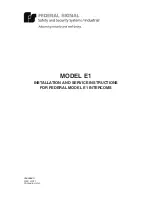
4-4
|
ni.com
Chapter 4
Analog Input
frequency of the lowpass filter is also called the small signal bandwidth. The specifications
document for your DAQ device lists the small signal bandwidth.
On some devices, the filter cutoff is fixed. On other devices, this filter is programmable and can
be enabled for a lower frequency. For example, the NI 628
x
devices have a programmable filter
with a cutoff frequency of 40 kHz that can be enabled. If the programmable filter is not enabled,
the cutoff frequency is fixed at 750 kHz. If the cutoff is programmable, choose the lower cutoff
to reduce measurement noise. However, a filter with a lower cutoff frequency increases the
settling time of your device, as shown in the specifications, which reduces its maximum
conversion rate. Therefore, you may have to reduce the rate of your AI Convert and AI Sample
Clocks. If that reduced sample rate is too slow for your application, select the higher cutoff
frequency.
Add additional filters to AI signals using external accessories, as described in the
Analog Input Ground-Reference Settings
M Series devices support the analog input ground-reference settings:
•
Differential mode
—In DIFF mode, the M Series device measures the difference in voltage
between two AI signals.
•
Referenced single-ended mode
—In RSE mode, the M Series device measures the voltage
of an AI signal relative to AI GND.
•
Non-referenced single-ended mode
—In NRSE mode, the M Series device measures the
voltage of an AI signal relative to one of the AI SENSE or AI SENSE 2 inputs.
The AI ground-reference setting determines how you should connect your AI signals to the
M Series device. Refer to the
Connecting Analog Input Signals
section for more information.
Ground-reference settings are programmed on a per-channel basis. For example, you might
configure the device to scan 12 channels—four differentially-configured channels and
eight single-ended channels.
M Series devices implement the different analog input ground-reference settings by routing
different signals to the NI-PGIA. The NI-PGIA is a differential amplifier. That is, the NI-PGIA
amplifies (or attenuates) the difference in voltage between its two inputs. The NI-PGIA drives
the ADC with this amplified voltage. The amount of amplification (the gain), is determined by
the analog input range, as shown in Figure 4-2.
Summary of Contents for PXI-6289
Page 1: ...PXI 6289...















































